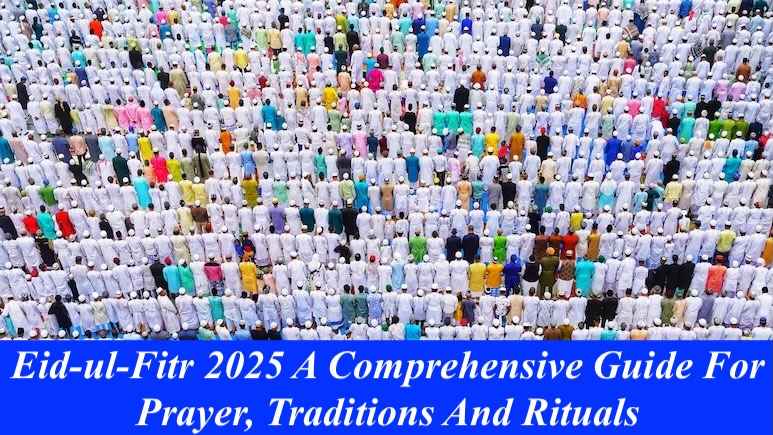Eid-ul-Fitr 2025 A Comprehensive Guide to Prayer, Traditions, and Rituals Eid-ul-Fitr, also known as Meethi Eid, is one of the most significant festivals celebrated by Muslims worldwide. This festival marks the conclusion of Ramadan, the holy month of fasting and spiritual reflection. Eid-ul-Fitr is a joyous occasion, celebrated with enthusiasm, prayers, community gatherings, and acts of charity.
Eid-ul-Fitr 2025:
As the festival is determined by the sighting of the Shawwal crescent moon, the exact date of celebration varies depending on the geographical location. This year, with Ramadan beginning on March 2, 2025, in India, Eid-ul-Fitr is expected to be celebrated on March 31 or April 1, 2025, based on the moon sighting.
This article provides a comprehensive guide to understanding the importance of Eid-ul-Fitr in 2025, the correct way to perform the Eid prayers, the traditions associated with the festival, and the spirit of togetherness that defines the occasion.
Key Dates for Eid-ul-Fitr 2025
|
Event |
Date |
|
Start of Ramadan |
March 2, 2025 |
|
End of Ramadan (Eid) |
March 31, 2025 or April 1, 2025 |
|
Crescent Moon Sighting |
March 31, 2025 or April 1, 2025 |
The Significance of Eid-ul-Fitr
Eid-ul-Fitr, the “Festival of Breaking the Fast,” marks the conclusion of the month-long fast of Ramadan. This is a time of spiritual reflection, community gathering, and gratitude for the strength to complete the month of fasting. The term Meethi Eid (Sweet Eid) highlights the sweetness of the occasion, symbolized by the exchange of sweets and the joy of the festival.
Eid-ul-Fitr Prayer: The Spiritual Heart of the Festival
Eid prayers are an essential part of the celebrations, offering Muslims a chance to come together in congregation, reflect on the mercy of Allah, and celebrate the strength gained during Ramadan.
How to Perform the Eid Prayer: A Step-by-Step Guide
- Intention (Niyyah): Make a firm intention to perform the Eid prayer (two Rakats).
- First Takbir: Begin the prayer by raising both hands and saying “Allahu Akbar” (Allah is the Greatest). Follow this by saying “Allahu Akbar” three additional times.
- Recite Surah Al-Fatihah: After the Takbirs, recite Surah Al-Fatihah, followed by another Surah from the Qur’an.
- Second Rakat: Stand for the second Rakat, recite the Takbirs again, and bow into Ruku (bowing posture).
- Dua and Khutbah: After completing the prayer, listen to the Eid Khutbah (sermon), followed by Dua (supplication) for the community and the world.
Eid-ul-Fitr Traditions: Celebrating with Family, Charity, and Unity
Eid is not only about prayers but also about spreading joy and goodwill to others. There are numerous traditions that make this occasion meaningful, including:
Sadaqat al-Fitr: Charity and Giving
One of the key acts of worship associated with Eid-ul-Fitr is Sadaqat al-Fitr, a form of charity given before the Eid prayer. This charitable act ensures that the less fortunate can partake in the festivities, even if they do not have the means to celebrate.
Special Prayers and Gatherings
On Eid morning, Muslims gather in large congregations at mosques or open grounds to perform the Eid namaz (prayer). These prayers are typically offered in a congregation, emphasizing the communal nature of the occasion.
Visiting Family and Friends: The Spirit of Togetherness
Eid is a time for families to come together. Muslims visit relatives and friends, exchange gifts, and share meals. Eid sweets like sewaiyan (vermicelli) and dates are common offerings. The sharing of these treats symbolizes the sweetness of life and the joy of the occasion.
New Clothes and Grooming: A Symbol of Renewal
It is customary to wear new or fine clothes for Eid prayers. This symbolizes a new beginning, with Muslims starting the month of Shawwal in the best of spirits. The act of grooming and presenting oneself neatly reflects the renewal of the spirit after the month of fasting.
The Eid Feast: A Celebration of Abundance
After the Eid prayers, families come together to share a festive meal. The meals often feature a variety of traditional dishes and sweets. The meal symbolizes the abundance granted by Allah after a month of fasting.
Final Thoughts: Embracing the Spirit of Eid
Eid-ul-Fitr is a time for Muslims to celebrate the successful completion of Ramadan, deepen their connection with Allah, and come together with family, friends, and community members. Whether through prayer, charity, or simply sharing a meal, Eid fosters a sense of unity and peace that extends beyond the individual. As Muslims around the world celebrate this special occasion, the focus remains on gratitude, community, and faith.
This comprehensive guide to Eid-ul-Fitr 2025 serves as a reminder of the true essence of the festival: an opportunity for personal growth, community togetherness, and charity. May this Eid bring peace, happiness, and blessings to all.
